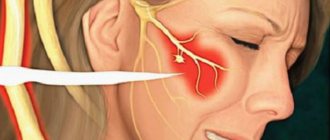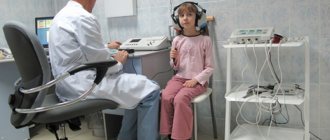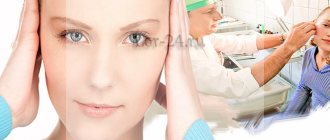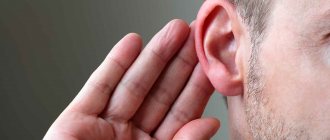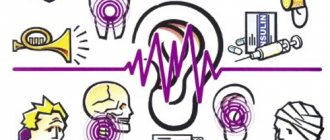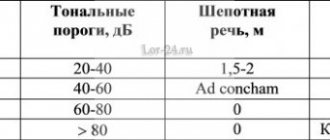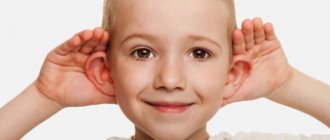Cochlear neuritis of the auditory nerve is a serious disease that results in hearing loss and noise in the affected organ. The latter worries constantly, which causes discomfort to the person. Deterioration of hearing is due to the fact that the transmission of the signal that comes from the hairs of the cells in the inner part of the ear to the brain is disrupted. Thus, the auditory nerve changes, and the sensitivity of the organ cells increases.
Anatomy of the auditory nerve
The auditory nerve belongs to the 8th pair of cranial nerves.
Features of the development of sensorineural hearing loss and their connection with the anatomy of the auditory nerve can be traced in such moments as:
- The auditory nerve has a fibrous structure, which is represented by plexuses of nerve fibers. They are unevenly distributed. Along the edge of the barrel there are fibers that are responsible for transmitting low-frequency sounds. The fibers running in the center transmit high-pitched sounds. Therefore, with sensorineural hearing loss, first of all, a person ceases to distinguish low tones.
- Since the vestibular part of the eighth pair of cranial nerves goes along with the auditory pair, with the development of sensorineural hearing loss, people often suffer from dizziness, nausea, and poor balance.
- In the early stages of development of the pathology, complete deafness is not observed, since the nerve trunk is damaged gradually.
- If the auditory nerve suffers from lack of oxygen for a long time, it begins to die. This will result in permanent deafness.
With sensorineural hearing loss, the part of the auditory nerve that is located outside the brain is affected. Therefore, a person most often becomes deaf in one ear. Although sometimes the pathological process develops from both sides at once.
Classification of the disease
Depending on the concentration of the pathological process, the following types of sensorineural hearing loss are distinguished:
- Unilateral lesion (observed most often).
- Bilateral pathology. It, in turn, can be symmetrical and asymmetrical. With symmetrical damage, both ears begin to perceive sounds equally poorly. With asymmetric hearing loss, hearing impairment has varying degrees of severity.
Depending on the rate of progression of the disease, the following types are distinguished:
- Sudden hearing loss that develops within 12 hours. Symptoms may persist for 14-21 days.
- Acute hearing loss that develops within 3 days. Its maximum duration is 5 weeks.
- Subacute hearing loss, which develops over 7-21 days. Symptoms of the disease persist for 1-3 months.
- Chronic hearing loss, which develops over 1-3 weeks and persists for longer than 3 months. Sometimes hearing cannot be restored.
Treatment of acoustic neuritis with folk remedies
The following folk remedies are recommended for the treatment of acoustic neuritis:
- A mixture of alcoholic tincture of propolis with oil . To prepare an alcohol tincture, grind propolis (40 grams) and pour it with alcohol (100 ml) in a glass container. Keep the mixture for 7 days in a warm place, away from light and shake periodically. Mix the filtered tincture with olive or corn oil, maintaining a ratio of 1 to 4 and mix well. Soak a gauze turunda in the mixture and insert it into the ear canal for 24 hours. Perform the procedure every other day, shaking the mixture well before use. A total of 12-14 procedures will be required.
- Camphor oil with garlic . Grind the garlic (1/3 of a clove) and add camphor oil (3 drops) to it. Wrap the resulting mixture in a bandage and form a turunda. Keep it in your ear until it burns, and then remove it. Carry out the procedures until you see positive results. Taking garlic tincture orally will also help alleviate the condition and improve hearing. To prepare the tincture, chop the garlic (40 grams) and pour vodka (100 ml) over it. Keep the mixture for 10 days and filter. Take 10 ml of tincture three times a day, diluting it in two tablespoons of water, 15-20 minutes before starting a meal. A tincture of garlic and apple cider vinegar is an effective remedy for treating a knee injury from a fall.
- Golden mustache decoction . Grind the golden mustache leaves (three pieces) and fill them with hot water (a glass). Boil the mixture over low heat for 3-5 minutes and pour into a thermos to infuse for 12 hours. Take the filtered infusion 3-4 times a day, one teaspoon. Continue treatment for 2 weeks.
- Vodka tincture of juniper berries . Take a glass container (100 ml) and fill it halfway with juniper berries. Fill to the top with vodka and leave at room temperature without access to light for 21 days, shaking the contents periodically. Place the filtered tincture in the ear before bed, 2-3 drops.
- Onion juice . Peel the onion and grind it into a paste by grinding it in a meat grinder or grating it on a fine grater. Squeeze the juice out of the pulp and dilute it with vodka or alcohol, maintaining a ratio of 1 to 4. Instill 1-2 drops in the affected ear twice a day.
- Fireweed herb decoction . Brew dried fireweed leaves (two tablespoons) with boiling water (a glass) and simmer the mixture over low heat for 8-10 minutes. Place a slightly warm decoction in the ear, 5 drops each, until complete recovery.
- Decoction of dogwood leaves . Brew crushed dogwood leaves (20 pieces) with hot water (100 ml) and boil for 3-5 minutes. Place the filtered, cooled decoction in both ears twice a day, dropping 3 drops.
- Tincture of anise seeds with rosehip oil . Grind the anise seeds into powder and fill any glass container 1/4 full. Add the remaining volume with rosehip oil purchased at the pharmacy and leave the mixture to infuse for 3 weeks. Use the prepared tincture at night, instilling 3 drops into each ear until complete recovery.
- A mixture of mumiyo with rose oil . Mix mumiyo (0.3 grams) with rose oil (3 ml) and heat the mixture in a water bath. Drip the product warm at night, 3-5 drops. The course of application is 14 days.
- A mixture of freshly squeezed juices . Mix freshly squeezed juices of Kalanchoe, aloe, onion and vodka in equal quantities. Instill the product warm twice a day, 3 drops. Fresh aloe juice is also used to treat scleroderma.
To treat acoustic neuritis, the following drugs are taken orally:
- Soya beans . Soak the soybeans for 7-8 hours, then remove the skins and grind them into a paste. Pour 1/2 part of water and dilute 1/3 part of a glass of bean paste in it. Bring this mixture to a boil, let cool and filter. Take the decoction at night, adding honey to taste.
- Decoction of hop cones . Brew hop cones (a tablespoon) with boiling water (a glass) and simmer the product over low heat for 15-20 minutes. Take the entire portion of the filtered decoction hot once a day at night.
- Birch tar with milk . Add pure birch tar (a teaspoon) to warm milk (a glass) and mix well. Take the product between meals three times a day. The course of admission is 1.5 months. Birch tar is also used to treat pityriasis rosea.
- Lemon . Throughout the day, eat 1/4 of a lemon along with the zest.
- Vitamin mixture . Mix lemon juice (squeezed from 10 lemons), garlic (10 heads), crushed into pulp using a meat grinder or garlic press, and honey (1 kg). Place everything in a glass container and close tightly. Infuse the product for 7 days, stirring daily. Take a teaspoon of the mixture before meals, three times a day.
When treating acoustic neuritis, any dry heat is also useful. You can warm your ear with compresses with salt, sand or flax seeds. To do this, heat any of the listed products in a frying pan, pour into a fabric bag or sock and apply to your ear until it cools completely.
It is recommended to carry out applications using copper plates or coins. Using a plaster, attach copper coins (pre-1961) in front of the auricle and on the mastoid area. Wear the coins for 2-3 days, then take a break for a few days and repeat the applications.
Degrees of sensorineural hearing loss
Depending on the frequency of sounds a person can perceive, the degrees of hearing loss vary:
- From 25 to 39 dB – 1 degree of hearing loss. A person can hear whispers at a distance of 3 meters, and spoken speech at a distance of 6 meters.
- From 40 to 54 dB – 2nd degree of hearing loss. He can distinguish whispers at a distance of a meter, and spoken speech at a distance of 4 m.
- From 55 to 69 dB – 3rd degree of hearing loss. A person cannot distinguish a whisper at all, but a person cannot distinguish spoken speech at a distance of 1 m.
- From 70 to 89 dB – 4th degree of hearing loss. A person can only hear loud speech if someone shouts directly into his ear.
- Above 90 dB – complete deafness. The person does not hear speech at all.
Forms of development
Depending on how long you have been developing the disease, it can take several forms, including the following:
- Acute - in the presence of this form, the disease develops very rapidly. It can begin to progress at the very beginning. Since there are no visible changes, many believe that hearing acuity is reduced due to the presence of cerumen.
- Chronic form - the disease begins to develop unnoticed. This form can become acute, but this is only if there is no treatment or it was not carried out completely.
Treatment of cochlear neuritis must be carried out without fail, otherwise you may encounter numerous complications.
Causes of sensorineural hearing loss
With sensorineural hearing loss, the nerve always does not receive enough nutrition and is pinched by some structures, for example, edematous tissues, a growing tumor, etc.
Such violations may be due to the following reasons:
- Past infections.
Some viruses and microbes can damage nerve tissue, which leads to irreversible consequences. Therefore, hearing loss can be a consequence of acute respiratory viral infections, herpes, influenza, mumps, meningitis, and neurosyphilis.
- Vascular pathologies:
atherosclerosis, impaired circulation in the vertebrobasilar system, hypertension, diabetes mellitus. All these diseases lead to the fact that the hearing receptors do not receive enough nutrition and oxygen. They gradually begin to lose their function and the person becomes deaf. In addition, blood microcirculation in the structure of the nerve trunk is disrupted.
- Spinal diseases.
These include spondylosis, uncovertebral arthrosis, spondylolisthesis, accompanied by the development of vertebral artery syndrome.
- Injuries received:
TBI, injury to the hearing aid due to exposure to loud sounds, barotrauma, which occurs during sudden changes in pressure. Most often, it is the receptors of the auditory nerve that are injured, but with strong blows to the temple area, its trunk can be damaged.
- Chemical poisoning.
Alcohol, nicotine, arsenic, mercury, benzene, aniline, hydrogen sulfide, and fluorine can damage the auditory nerve and lead to the development of hearing loss. In this regard, drugs such as Streptomycin, Gentamicin, Vancomycin pose a danger. Amikacin, Cisplatin, Endoxan, Quinidine and drugs for the treatment of malaria.
- Irradiation of the body.
Sensorineural hearing loss rarely develops due to exposure to radiation. This can happen when patients undergo radiation therapy for the treatment of cancerous tumors, as well as when they come into contact with a radiation source during an emergency. Radiation can destroy any tissue in the human body, but nerves are rarely affected.
Sometimes the causes of sensorineural hearing loss cannot be determined. In this case, they speak of the idiopathic form of the disease.
Causes of acoustic neuritis
The causes of the development of acoustic neuritis are the following factors:
- past infectious diseases: ARVI, influenza, rubella, mumps, measles, scarlet fever, meningitis and others,
- long-term use of certain groups of drugs: streptomycin, neomycin, quinines, salicylates, antibiotics,
- intoxication of the body: poisons (arsenic, lead, mercury, phosphorus and others), alcohol, nicotine, toxins, heavy metals and harmful substances,
- systematic exposure to increased noise or vibration,
- mechanical injuries to the head that impair blood circulation and promote swelling,
- hypertension, atherosclerosis, sudden changes in pressure, stroke,
- various diseases causing metabolic disorders,
- kidney and heart diseases,
- tumors of various etiologies,
- age-related changes.
Symptoms of sensorineural hearing loss
The first symptom of auditory neuritis is hearing loss. First, a person begins to hear low tones, such as bass, worse. As the pathology progresses, the audibility of high-frequency sounds worsens.
About 92% of patients complain of tinnitus, which can occur on one or both sides. The timbre of the noise varies, one tone transforms into another. At the same time, the ears do not hurt with acoustic neuritis, unless the disorder develops due to an injury.
Other symptoms of sensorineural hearing loss include:
- Dizziness.
- Unsteadiness of gait.
- Deterioration of coordination.
- Nausea, which may result in vomiting.
Diagnostics
Patients with suspected sensorineural hearing loss are hospitalized. A preliminary diagnosis is made based on the patient’s complaints.
In a specialized hospital, he is prescribed a number of examinations:
- Speech hearing test. The doctor stands 6 meters away from the patient and begins to whisper words in a low tone, and then with high sounds. If a person does not hear what exactly the doctor is saying, then he begins to approach him closer. Normally, the patient should hear a whisper already at a distance of 6 meters.
- Hearing test using a tuning fork. This is an instrument that produces sounds of different frequencies. A tuning fork is used to perform the Rinne test (if hearing deteriorates, the test result will be negative) and the Weber test (a healthy ear will hear sounds better).
- Hearing examination using audiometry method. To carry out the test, a device called an audiometer is used. The patient is asked to listen to sounds of different frequencies, and the device will record the tones that he hears. Based on the data obtained, a curve is built that displays the hearing function. There are several types of audiometry: tone suprathreshold audiometry, auditory sensitivity to ultrasound method, speech audiometry.
If a tumor growing in the temporal region is suspected, the patient is referred for a computed tomography scan. Another diagnostic method that clarifies the cause is ultrasound of the vessels of the vertebrobasilar region.
Treatment
Therapy largely determines the form of auditory neuritis. Therefore, these areas need to be considered separately.
Treatment of acute hearing loss
Patients with this diagnosis are immediately hospitalized. In this case, it is necessary to exclude any factors that damage his hearing, including loud sounds.
Drug therapy comes down to the prescription of drugs such as:
- Hormonal agents, in particular Dexamethasone. It is administered intravenously. The course of treatment is a week, after which the dose is gradually reduced.
- Drugs that help normalize blood microcirculation: Vinpocetine, Pentoxifylline. They are administered intravenously. The course of treatment is 8-10 days.
- Vitamin E, ascorbic acid, Ethylmethylhydroxypyridine succinate. These drugs are used in the treatment of hearing loss, as they have pronounced antioxidant properties.
If the course of treatment with some drug must be extended, then it is no longer administered intravenously, but is prescribed for oral administration.
Treatment of chronic and subacute forms of neuritis
To stop the progression of the disease, the following measures must be implemented:
- Creating a protective hearing regime for the patient.
- Treatment of diseases that led to the development of neuritis.
- The use of a treatment regimen prescribed for the acute form of the disease. For chronic hearing loss, it is practiced 2 times a year.
If hearing loss worsens a person’s quality of life, then it is advisable to use special devices that can bring it back to normal.
Treatment methods
Cochlear neuritis must be treated in a medical facility. In this case, the patient is admitted to the hospital. He must strictly follow the requirements for nutrition and hearing regimen. This applies not only to the chronic form of the disease, but also to the sudden one.
It is important to note that treatment is most effective when it is carried out at the first signs of the disease.
Therefore, it is necessary to respond to hearing loss immediately. Go to a specialist to determine the cause of the problem.
There are several methods of treating the disease:
- therapeutic;
- conservative;
- physiotherapy;
- surgical.
Therapeutic method of treatment
At the initial stage of the disease, specialists mainly prescribe therapeutic therapy. It consists of treating the underlying disease using medications that will help:
- restore blood circulation;
- stabilize blood pressure;
- will reduce blood viscosity;
- normalize blood circulation in the brain;
- will improve the process of transmission of impulses in the area of the hearing nerve.
Conservative therapy
If we talk about conservative therapy, it is aimed at suppressing the activity of microorganisms that have become the causative agents of the disease.
In this case, special attention is paid to the removal of toxic products that have entered the human body. During treatment, antibiotics, anti-inflammatory agents, hemodesis, etc. are used.
Experts resort to a conservative method of treatment for acute neuritis. Therapy is carried out according to a certain scheme.
So, in the first two weeks, drugs such as Mexidol, pentoxifylline, etc. are administered intravenously. In addition, venotonics are prescribed. The use of a drug such as ginkgo biloba also has a positive effect.
The disease is accompanied by dizziness. To alleviate the patient's condition, betahistidine is used. This will significantly improve microcirculation processes in the hearing organ. It is also important to pay special attention to tissue metabolism. To improve it, electrophonophoresis is used.
Physiotherapy
Physiotherapy is often used to treat acute forms of the disease. It is an effective method. Laser therapy, plasmapheresis and much more are used. In this way, the work of the inner ear is stimulated.
If hearing has deteriorated significantly and the acute form has already become chronic, then the hearing aid method is used. It involves installing a special device on the organ. At the same time, its settings can be adjusted, which allows for significant improvement in hearing.
The patient's adaptation to society goes well, and his quality of life improves. He feels like a full-fledged person who can hear all the sounds coming from the world around him.
Surgical intervention
Quite often, specialists resort to surgical intervention. The main prerequisites for it are the painful course of the disease, if the patient is bothered by constant noise in the organ of hearing, which becomes a real torment.
Surgical intervention involves specialists regulating the performance of nerve ganglia and their plexuses. Thus, they eliminate noise and other unpleasant phenomena in the organ.
At the same time, hearing improves significantly. This method is most effective when the death of sensitive hair cells in the area of the inner ear occurs.
Adaptation of patients with sensorineural hearing loss
Hearing loss is a serious problem. However, there are effective methods that allow such people to adapt to society.
These include:
- Hearing aids
with special devices.
Every person can receive such treatment absolutely free of charge if he is diagnosed with 2 or 3 degrees of hearing loss. Hearing aids can be either behind-the-ear or in-ear. With their help, a person begins to hear normally. -
middle ear
implant that can help people with grade 3 hearing loss. It is implanted if it is not possible to use an external hearing aid. - Cochlear
implant.
This drug is implanted in patients with grade 4 hearing loss, provided that other treatment methods have been ineffective. In addition, a person, of his own free will and at his own expense, can go to a private clinic where he will undergo surgery. The implant acts like a person's own ear, transmitting signals to the auditory nerve trunk and then to the brain.
The earlier treatment is started, the more effective it is. Therefore, when the first signs of hearing loss appear, you should seek medical help.
AUDITORY NEUROPATHY
What is auditory neuropathy?
Auditory neuropathy is a hearing disorder in which the inner ear successfully detects sound but has trouble sending sound from the ear to the brain. It can occur in people of all ages, from infancy to adulthood.
When these people's hearing is tested, the result may be normal hearing or mild to severe hearing loss. But such people’s ability to perceive speech is always much worse, that is, they have problems with a clear understanding of speech. For example, a person with auditory neuropathy may hear sounds but will still have difficulty recognizing spoken words because the sounds may disappear or appear out of sync for these people.
What causes auditory neuropathy?
There can be several causes of auditory neuropathy. In some cases, the cause may be damage to the inner hair cells—the specialized sensory cells in the inner ear that transmit information about sounds through the nervous system to the brain. In other cases, the cause may be damage to the auditory neurons, which transmit sound information from the inner hair cells to the brain. Other possible causes may include inheriting genes with mutations or damage to the auditory system, which can lead to disruption of communication between the inner hair cells and the auditory nerve (the nerve that leads from the inner ear to the brain) or damage to the auditory nerve itself. In some particularly complex cases, a combination of several of these problems may occur.
What are the roles of outer and inner hair cells?
Outer hair cells help amplify sound vibrations entering the inner ear from the middle ear. When hearing is functioning normally, inner hair cells convert auditory vibrations into electrical signals, which are transmitted as nerve impulses to the brain, where the brain interprets the impulses as sound.
Are there risk factors for developing auditory neuropathy?
There are several reasons why you may develop auditory neuropathy. Children diagnosed with auditory neuropathy experienced specific health problems before birth or as newborns. These include insufficient oxygen supply before birth, premature birth, jaundice, low birth weight and dietary thiamine deficiency. Additionally, some medications used to treat pregnant women or newborns can damage the baby's inner hair cells, causing auditory neuropathy. In adults, the onset and manifestation of auditory neuropathy is usually associated with age-related hearing loss. Auditory neuropathy runs in some families, and in some cases, scientists have identified genes with mutations that compromise the ear's ability to transmit sound information to the brain. Thus, inheritance of mutant genes is also a risk factor for the development of auditory neuropathy.
Some people with auditory neuropathy have neurological disorders that also cause problems outside the auditory system. Examples of such disorders are Charcot-Marie-Tooth disease (CMT), or hereditary motor sensory neuropathy (HMSN) and Friedrich's ataxia.
How is auditory neuropathy diagnosed?
Health care providers—including otolaryngologists (ear, nose, and throat doctors), pediatricians, and audiologists—use a combination of techniques to diagnose auditory neuropathy. These include auditory brainstem response (ABR) and otoacoustic emission (OAE) recording. The hallmark of auditory neuropathy is an absent or very abnormal CPMS reading along with a normal OAE reading. A normal OAE reading means the outer hair cells are working normally.
The SRMS test uses electrodes placed on a person's head and ears to monitor brain wave activity in response to sound. The OAE test uses a small, highly sensitive microphone inserted into the ear canal to monitor the faint sounds produced by the outer hair cells in response to auditory stimulation. CPMS and OAE testing is painless and can be used on newborns and infants, as well as older children and adults.
Can auditory neuropathy ever get better or worse?
Some newborn babies diagnosed with auditory neuropathy improve and begin to hear and speak within a year or two. Other babies remain at the same level, while some get worse and show signs that the outer hair cells are no longer functioning. In people with auditory neuropathy, hearing sensitivity may remain stable, improve or worsen, or gradually worsen, depending on the underlying cause of the condition.
What treatments, devices, and other approaches can help people with auditory neuropathy communicate?
Researchers are still searching for effective treatments for people with auditory neuropathy. Meanwhile, hearing experts disagree about the potential benefits of hearing aids, cochlear implants, and other technologies for people with auditory neuropathy. Some experts believe that hearing aids and personal listening devices, such as frequency modulation (FM) systems, are helpful for some children and adults with auditory neuropathy. Cochlear implants (electronic devices that compensate for damaged or non-functioning parts of the inner ear) may also help some people with auditory neuropathy. There is also ongoing debate about the best ways to teach and improve communication skills in infants and children with hearing impairments such as auditory neuropathy. One approach favors sign language as the child's first language. The second approach encourages the use of listening and speaking skills, along with technologies such as hearing aids and cochlear implants. You can also use a combination of these two approaches. Some health professionals believe that children with auditory neuropathy may have a particularly difficult time learning to communicate using spoken language alone, as their ability to understand speech is often severely impaired. Adults with auditory neuropathy and older children who have already developed spoken language may benefit from learning to read speech (also known as lip reading).
What research is being done on auditory neuropathy?
Scientists have identified genes involved in some cases of auditory neuropathy and are working to determine what goes wrong in the auditory system when a person inherits a mutant gene. Researchers are also continuing to study the potential benefits of cochlear implants for children with auditory neuropathy.
Answers to popular questions
- Is it possible to cope with acoustic neuritis using traditional medicine methods?
No, they are not effective. However, some physiotherapeutic techniques can speed up recovery, for example, endaural electrophoresis with Dibazol, Nicotinic acid and other drugs, massage, and current treatment.
- Is hearing restored after therapy?
In 93% of cases in patients with acute hearing loss, hearing is restored within the first 30 days from the start of treatment. If the disease is chronic, the prognosis worsens.
- What can replace a hearing aid?
You can resort to the method of vibrosound stimulation, pedagogical activation of hearing, and electroreflexotherapy. They allow you to restore the receptors of the damaged nerve, but their effectiveness is lower than when wearing a hearing aid. In addition, these techniques are not widely used in Russia.
- Is the disease inherited?
Hearing loss can be transmitted by syphilis, congenital otosclerosis and progressive labyrinthitis.
- How to improve vestibular function with neuritis?
It is possible to use nootropic drugs, as well as anticholinesterase drugs, for example, Neuromidin.
Author of the article:
Sokov Andrey Vladimirovich |
Neurologist Education: In 2005, she completed an internship at the First Moscow State Medical University named after I.M. Sechenov and received a diploma in the specialty “Neurology”. In 2009, she completed her postgraduate studies in the specialty “Nervous Diseases”. Our authors
